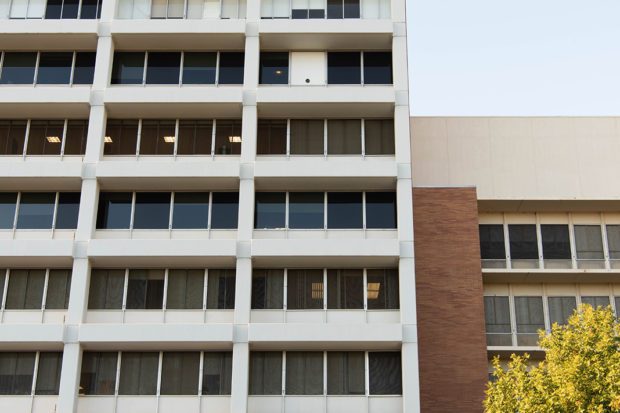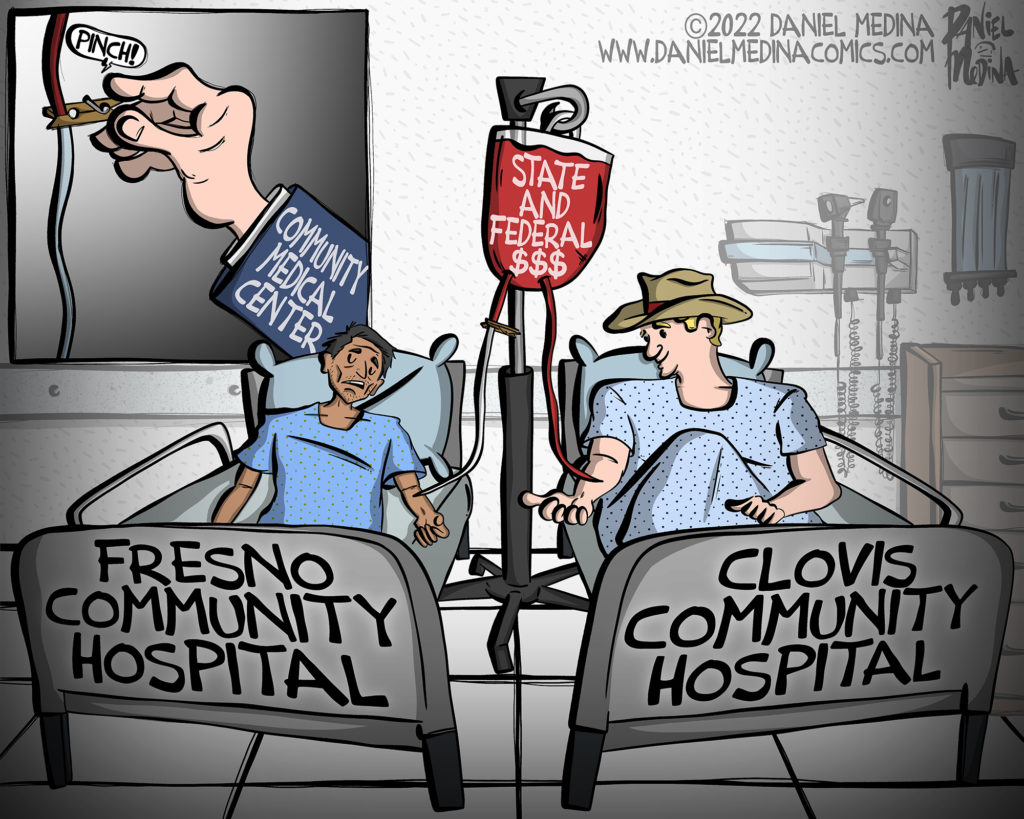

History of Segregation and Disinvestment
Fresno was founded in April 1872, when the robber baron (some prefer “captain of industry”) Leland Stanford designated a site for a railway station depot for his Central Pacific Railroad. Initial development was around the depot.
Since then, land speculators and real estate developers have guided the development of Fresno. A number of the land speculators and early settlers who were involved in Fresno’s initial development had served in the Confederacy. As a result, there has always been racial segregation in Fresno.
Disinvestment of poorer, non-White areas in favor of investment in wealthier White area dates back to the beginning of the city of Fresno.
In 1873, White settlers decided that the land east of the railroad tracks was to be sold only to other White settlers. Chinese workers were forced to live on the land west of the railroad tracks. When Black and Latino workers came to Fresno in the 1920s, they were also confined to the west side.
Gambling dens, prostitution, landfills, slaughterhouses, rendering plants and pollution-producing activities were confined to the west side. The City of Fresno, the County of Fresno, developers and businesses would invest in schools, buildings, stores, banks and hospitals in the land east of the railroad tracks but not the land west of the tracks, also known as West Fresno.
What Is Disinvestment?
Disinvestment occurs when public and/or private funds that would benefit a certain community are not spent on the development of that community. Rather, the resources that would benefit the community are used elsewhere. Often, revenue is sent to less needy or wealthier areas. Disinvestment results in a downward socioeconomic spiral of the poorer area, which leads to further disinvestment and further poverty.
Since the founding of Fresno, the private and public capital flow of investment money has been toward north Fresno and Clovis. An area to the north will be developed, then leapfrogged and forgotten while another area further north is developed leaving the previous development with fewer resources. These practices have continued to the present day.
Like other cities in the United States, disinvestment in poorer areas of Fresno, which is often racially based, can be seen by the neighborhood racial disparities in housing, life expectancy, education, healthcare, jobs, income and environmental justice.
CMC Becomes Safety Net Provider
In August, the Fresno Bee published several articles by investigative reporter Yesenia Amaro. These articles explained how Community Medical Centers (CMC), aka Community Health System (CHS), the largest, local, private, nonprofit healthcare system in Fresno, is disinvesting in the safety net healthcare provider for the area, Community Regional Medical Center (CRMC).
In 1996, CRMC lost its $20 million a year contract with Kaiser to provide hospital care for Kaiser patients. CMC needed to increase the number of patients in their hospitals to counter the loss of revenue. In 1996, CMC entered into a contract with Fresno County to provide care to poor and indigent county residents.
Ultimately, CRMC would transition to become the safety net provider for the region. In exchange, the County agreed to pay about $20 million a year through a 30-year comprehensive fixed payment agreement. That money was to be used to provide patient care, build an ICU and a burn unit and help fund the Emergency Department.
Safety net hospitals provide healthcare for individuals regardless of their insurance status or their ability to pay. Valley Medical Center (VMC), also known as the University Medical Center (UMC), had been the area’s safety net hospital since 1890. With the closure of VMC in 2007, all care of poor, county Medi-Cal contracts and indigent patients was transferred from the responsibility of Fresno County to CMC. In addition, CMC assumed responsibility for burn unit care and Level I trauma care.
Since then, CMRC has been the sole safety net healthcare provider.
History of CMC
The private, nonprofit corporation of Fresno Community Hospital has had a presence in Fresno since it bought the Burnett Sanitarium in 1945 at Fresno and R streets. In 1974, Fresno Community Hospital and Medical Centers became the legal nonprofit corporate entity controlling Fresno Community Hospital.
In 1979, the private nonprofit Fresno Community Hospital became Fresno Community Hospital and Medical Centers (FCHMC). FCHMC merged with Clovis Memorial Hospital, which was renamed Clovis Community Hospital (CCH). CCH’s name was later changed to its current name of Clovis Community Medical Center (CCMC).
In 1999, CMC became the umbrella term to describe the not-for-profit 501(c)(3) corporation. In June 2021, CMC began to refer to itself as Community Health System (CHS) instead of CMC because CHS better described the role it played in the local healthcare scene. CMC/CHS owns or is affiliated with the following entities:
- Owns four hospitals (CRMC, CCMC, Fresno Heart & Surgical Hospital and the acute locked psych facility) that provide healthcare to residents in the area
- Has several large administration systems to run the facilities and the organizations
- Has an HMO (Community Health Care)
- Has the fundraising Community Health Foundation
- Is affiliated with or owns several doctors’ organizations
- Runs a medical residency program
CMC is led by the Community Medical Centers Board of Trustees, “a 15-member group made up of community volunteers who have expertise in a variety of industries and professions.” The board of trustees is the governing body of the CMC/CHS nonprofit organization.
The board was previously chaired by Flo Dunn, co-owner and current president of California Health Sciences University (CHSU), a private, for-profit medical school located near the CCMC. The board is currently chaired by Farid Assemi. Assemi is a wealthy local real estate developer, pistachio farmer and, with Dunn, a co-owner of CHSU.
CMC has several obligations. CMC provides healthcare to patients and at the same time maintains fiduciary responsibility for the organization. Board members of CMC are expected to act in the best interests of the organization, which might not necessarily be in the best interests of the community where the nonprofit organization is located.
Under well-established principles of nonprofit corporation law, “nonprofit board members have the legal responsibility to meet the duty of care, the duty of loyalty and the duty of obedience.” Board members are not supposed to use their positions on boards for self-aggrandizement or self-dealing.
As a private nonprofit hospital organization, CMC is not owned by any local, state or federal government entity. CMC does receive funds for services from government entities such as Medicare, Medi-Cal, Workers’ Compensation, the state of California and Fresno County. Because it receives government funds (such as Hospital Quality Assurance Fees), it is required to provide the quality care and access demanded by those government entities paying for the services and to spend the revenue appropriately.
CMC Disinvests in CRMC
Private hospitals can be for-profit, driven by the financial bottom line, or nonprofit, which are more service-oriented. Publicly funded hospitals are all nonprofit. Rather than returning any profit to shareholders, as would a for-profit hospital, nonprofit hospitals reinvest revenue for services rendered that is above the cost of the service (“profit”) back into the hospital.
A nonprofit hospital is usually owned by a charitable organization or a nonprofit corporation (like Fresno Community Hospital and Medical Centers). From a tax viewpoint, nonprofit hospitals are looked upon as a benefit to the community. Because of their perceived community benefit, nonprofit hospitals do not pay federal income tax, state income tax or local property taxes.
Since 2010, the California Department of Health Service has funded the Hospital Quality Assurance Fee (HQAF) program to provide “funding for supplemental payments to California hospitals that serve Medi-Cal and uninsured patients.” Over a 10-year period, the HQAF program sent $1.2 billion to support CRMC’s work in caring for poor patients, patients with Medi-Cal and indigent patients. Instead of investing in CMRC, CMC used $1 billion for the hospital expansion program at CCMC.
The Fresno Bee articles raised major concerns about the ethics of the disinvestment in Downtown Fresno’s CRMC for the betterment of Clovis’s CCMC. This is not the first time CMC has used funds designated for poor or indigent patients to fund facilities that serve a wealthier and whiter group of patients. This was done before in the late 1990s and early 2000s when CMC spent millions of dollars on a joint venture with local cardiologists to fund the Fresno Heart Hospital located in north Fresno.
After four years of planning and development, the Fresno Heart Hospital opened in 2003. CMC sustained severe financial losses of millions of dollars annually. Ultimately, CMC bought out the physicians and assumed complete ownership of the Fresno Heart Hospital in 2007. It was renamed Fresno Heart & Surgical Hospital (FHSH) and expanded its services beyond cardiac procedures.
Just like now, local developers might have benefited from CMC building the Fresno Heart Hospital near land owned by family members of the CMC board. Ed Kashian, the Fresno real estate developer of River Park, “served on the Board of Trustees for the Community Hospital Medical System from 1992 to 2002, the last five as Board Chairman. Under his leadership as CMC board chairman, the hospital acquired Valley Medical Center from Fresno County.
“Allegations arose that CMC chairman Ed Kashian’s son-in-law, a real estate agent, was benefiting handsomely from the hospital’s real estate activities, particularly for the new heart hospital. Kashian would eventually resign in the wake of the allegations.”
CMC says that sending money from CRMC to CCMC was best for CMC to provide care to the wider region. CMC did not address the needs of CRMC, which needs to be retrofitted to withstand earthquakes or be demolished and rebuilt. CMC did not say sending CRMC’s HQAF money to CCMC was best for the people who live in the area of CRMC, the people who get their care from CRMC or for the long-term benefit of CRMC.
It appears CMC is disinvesting from CRMC by taking state funds designated for CRMC and investing that money in CCMC. The ethics of CMC sending state money, designated for CMRC, which is located in a poor area of Fresno, to a wealthier area is questionable.
The legality of CMC’s disinvestment, and whether there is any self-dealing by members of the CMC Board, will require evaluation by lawyers from various government agencies including the Department of Health Services, the HQFA program, Medicare, Medi-Cal, the IRS and/or the FBI.
